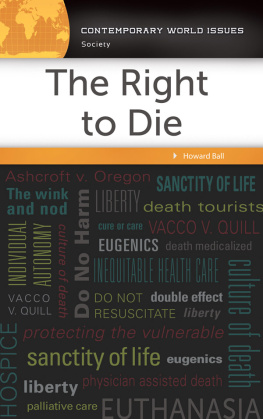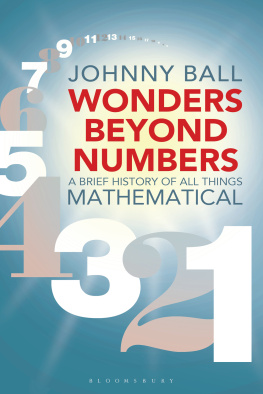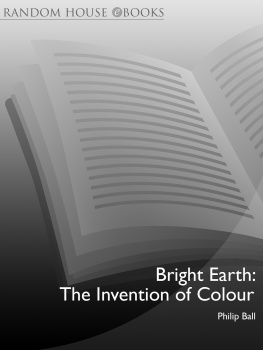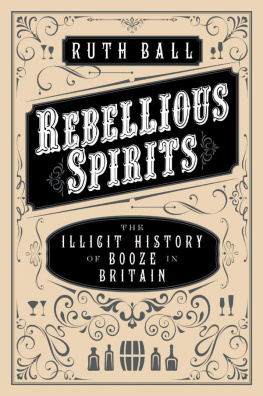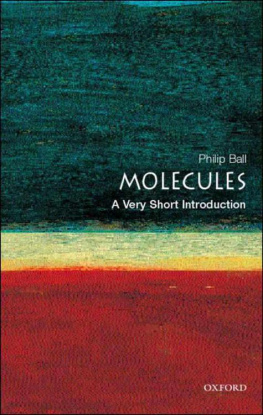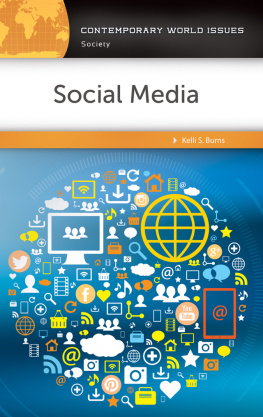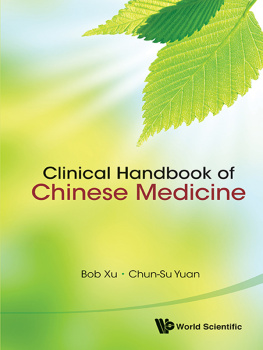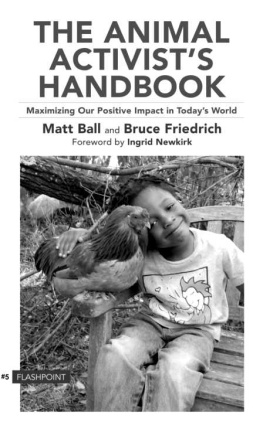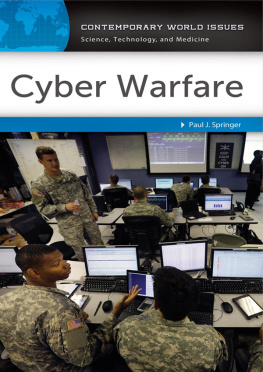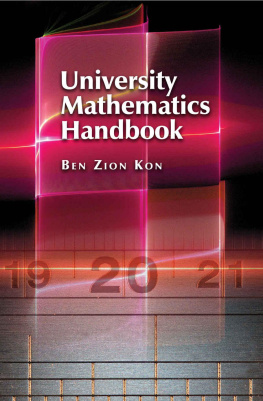Ball - The Right to Die: a Reference Handbook
Here you can read online Ball - The Right to Die: a Reference Handbook full text of the book (entire story) in english for free. Download pdf and epub, get meaning, cover and reviews about this ebook. City: Santa Barbara (California, year: 2017, publisher: ABC-CLIO, LLC, genre: Romance novel. Description of the work, (preface) as well as reviews are available. Best literature library LitArk.com created for fans of good reading and offers a wide selection of genres:
Romance novel
Science fiction
Adventure
Detective
Science
History
Home and family
Prose
Art
Politics
Computer
Non-fiction
Religion
Business
Children
Humor
Choose a favorite category and find really read worthwhile books. Enjoy immersion in the world of imagination, feel the emotions of the characters or learn something new for yourself, make an fascinating discovery.
- Book:The Right to Die: a Reference Handbook
- Author:
- Publisher:ABC-CLIO, LLC
- Genre:
- Year:2017
- City:Santa Barbara (California
- Rating:4 / 5
- Favourites:Add to favourites
- Your mark:
- 80
- 1
- 2
- 3
- 4
- 5
The Right to Die: a Reference Handbook: summary, description and annotation
We offer to read an annotation, description, summary or preface (depends on what the author of the book "The Right to Die: a Reference Handbook" wrote himself). If you haven't found the necessary information about the book — write in the comments, we will try to find it.
Ball: author's other books
Who wrote The Right to Die: a Reference Handbook? Find out the surname, the name of the author of the book and a list of all author's works by series.
The Right to Die: a Reference Handbook — read online for free the complete book (whole text) full work
Below is the text of the book, divided by pages. System saving the place of the last page read, allows you to conveniently read the book "The Right to Die: a Reference Handbook" online for free, without having to search again every time where you left off. Put a bookmark, and you can go to the page where you finished reading at any time.
Font size:
Interval:
Bookmark:

The Right to Die
Recent Titles in the
Contemporary World Issues
Series
Obesity: A Reference Handbook, second edition
Judith S. Stern and Alexandra Kazaks
Solar Energy: A Reference Handbook
David E. Newton
Prescription Drug Abuse: A Reference Handbook
David E. Newton
The Minimum Wage: A Reference Handbook
Oren M. Levin-Waldman
Juvenile Justice: A Reference Handbook, second edition
Donald J. Shoemaker and Timothy W. Wolfe
The Global Water Crisis: A Reference Handbook
David E. Newton
Youth Substance Abuse: A Reference Handbook
David E. Newton
Global Pandemic Threats: A Reference Handbook
Michael C. LeMay
Same-Sex Marriage: A Reference Handbook, second edition
David E. Newton
DNA Technology: A Reference Handbook, second edition
David E. Newton
Modern Sport Ethics: A Reference Handbook, second edition
Angela Lumpkin
Marijuana: A Reference Handbook, second edition
David E. Newton
Gun Control in the United States: A Reference Handbook, second edition
Gregg Lee Carter
Books in the Contemporary World Issues series address vital issues in todays society such as genetic engineering, pollution, and biodiversity. Written by professional writers, scholars, and nonacademic experts, these books are authoritative, clearly written, up to date, and objective. They provide a good starting point for research by high school and college students, scholars, and general readers as well as by legislators, businesspeople, activists, and others.
Each book, carefully organized and easy to use, contains an overview of the subject, a detailed chronology, biographical sketches, facts and data and/or documents and other primary source material, a forum of authoritative perspective essays, annotated lists of print and non-print resources, and an index.
Readers of books in the Contemporary World Issues series will find the information they need in order to have a better understanding of the social, political, environmental, and economic issues facing the world today.
CONTEMPORARY WORLD ISSUES

Copyright 2017 by ABC-CLIO, LLC
All rights reserved. No part of this publication may be reproduced, stored in a retrieval system, or transmitted, in any form or by any means, electronic, mechanical, photocopying, recording, or otherwise, except for the inclusion of brief quotations in a review, without prior permission in writing from the publisher.
Library of Congress Cataloging-in-Publication Data
Names: Ball, Howard, 1937 author.
Title: The right to die : a reference handbook / Howard Ball.
Description: Santa Barbara, California : ABC-CLIO, LLC,
[2017] | Series: Contemporary world issues | Includes
bibliographical references.
Identifiers: LCCN 2016042041 (print) | LCCN 2016045321
(ebook) | ISBN 9781440843112 (alk. paper) | ISBN
9781440843129 (ebook)
Subjects: LCSH: Right to dieUnited States. | Euthanasia
United States.
Classification: LCC R726 .B255 2017 (print) | LCC R726
(ebook) | DDC 179.7dc23
LC record available at https://lccn.loc.gov/2016042041
ISBN: 978-1-4408-4311-2
EISBN: 978-1-4408-4312-9
212019181712345
This book is also available as an eBook.
ABC-CLIO
An Imprint of ABC-CLIO, LLC
ABC-CLIO, LLC
130 Cremona Drive, P.O. Box 1911
Santa Barbara, California 931161911
www.abc-clio.com
This book is printed on acid-free paper 
Manufactured in the United States of America
For two persons who keep me from going off the rails:
Michael Bukanc and Jeffrey Rubman.
If we allow medicine to prolong life, should we also allow it to shorten life for the terminally ill?
Nora Zamichow and Ken Murray, 2014
It is necessary that [advocates on both sides] will need to work together and listen more closely to [each others] concerns about end-of-life cases.
Alicia Ouellette, 2013
Whatever the limits and travails we face, we want to retain the autonomythe freedomto be the authors of our lives. This is the very marrow of being human.
Atul Gawande, 2014
Not one of us decided the time or manner in which we come into the world. Our life is a sacred gift from God, and only He can give it. It is therefore His right alone to take us out of the world.
Father Frank A. Pavone, 2014
The Right to Die: A Reference Handbook examines the issue as it has evolved over the past century, giving prominence to the last 50 years because of these decades impact on how we die due to the exponential acceleration of scientific research and medical technological breakthroughs. As a result, Americans have been living much longer and, due to changes in how the medical community responds to accidents and illness, dying much more slowly and, frequently, in great pain. It is an examination that considers how these scientific-technological-medical advances impact the dying process.
examines the beliefs, values, and fears of all the participants in these ongoing ethical, medical, social, legal, and political battles about how we live and if and how we can determine how we will die. At its core, this book is about the hardnosed battles between those who believe that a person has a constitutionally protected liberty to die with the assistance of a physician and their opponents, who maintain that a host of ethical, religious, legal, and medical principles bar such medical aid to help a terminally ill patient to die.
The first chapter examines these battles from these two ardently opposed positions, providing readers with a clear understanding of the reasons for such profound disagreements. It will also provide the reader with the historical context within which are located the roots of this contentious issue in the 21st century.
underlines the importance of constitutional rights and liberties in the nations history, especially the ways in which fundamental human rights have been expanded through interpretations of the idea of liberty found in the U.S. and state constitutions. It took judicial decisions, legislative enactments, and presidential powers to enlarge the scope of liberty to include blacks, women, ethnic and religious minorities, the poor, and the gay and lesbian communities. The Civil War amendments (Thirteenth, Fourteenth, and Fifteenth, added in 1865, 1866, and 1868); the Nineteenth Amendment (1919); the Civil (1964) and Voting (1965) Rights Acts; and U.S. Supreme Court decisions in the areas of womens rights, marital privacy, marriage, and free speech are but a few examples of how the Constitution has evolved over two-plus centuries to expand the meaning of individual rights and liberties.
The clashes surrounding whether there is a right to die protected by the Constitution and by laws passed by government are discussed in general terms in . Democracy works, in great part, because of these figurative battles between opposing groups over how we live and die. Votes, not bullets, determine the outcome of such battles. But it is an outcome that will be challengedagain and againby the losers. That is the core of a democracy. On any issue of public concern, groupsreligious, social, economic, professional, political, and moralare created to push for rights allegedly denied them.
Font size:
Interval:
Bookmark:
Similar books «The Right to Die: a Reference Handbook»
Look at similar books to The Right to Die: a Reference Handbook. We have selected literature similar in name and meaning in the hope of providing readers with more options to find new, interesting, not yet read works.
Discussion, reviews of the book The Right to Die: a Reference Handbook and just readers' own opinions. Leave your comments, write what you think about the work, its meaning or the main characters. Specify what exactly you liked and what you didn't like, and why you think so.

